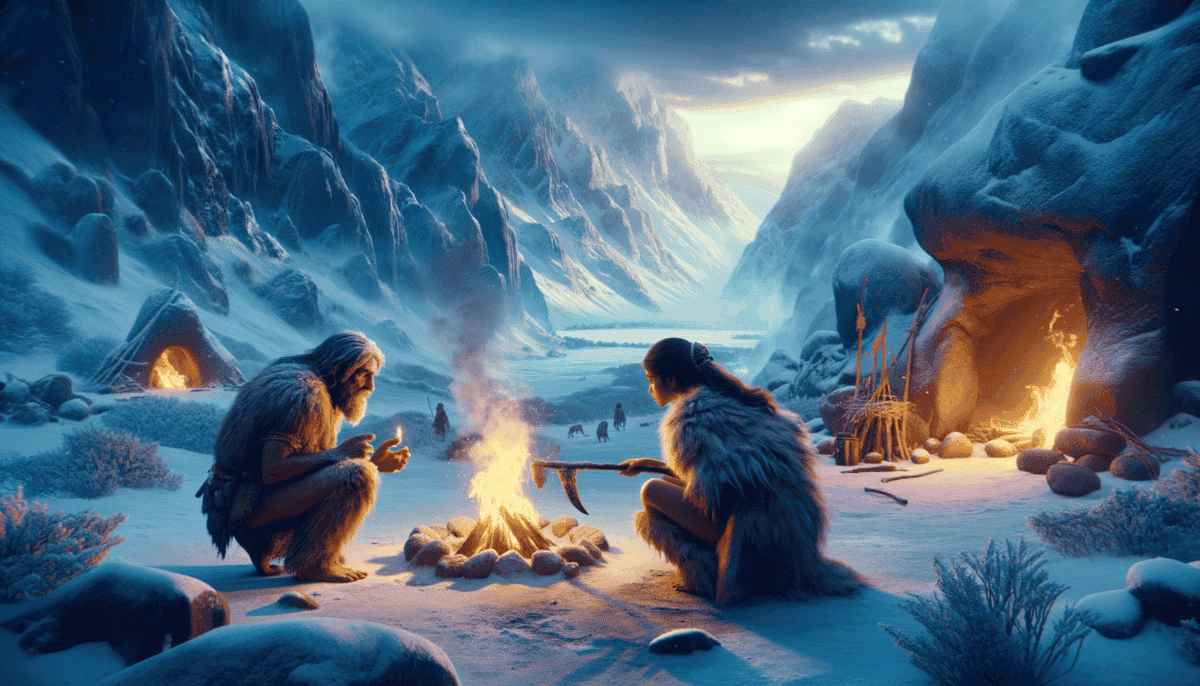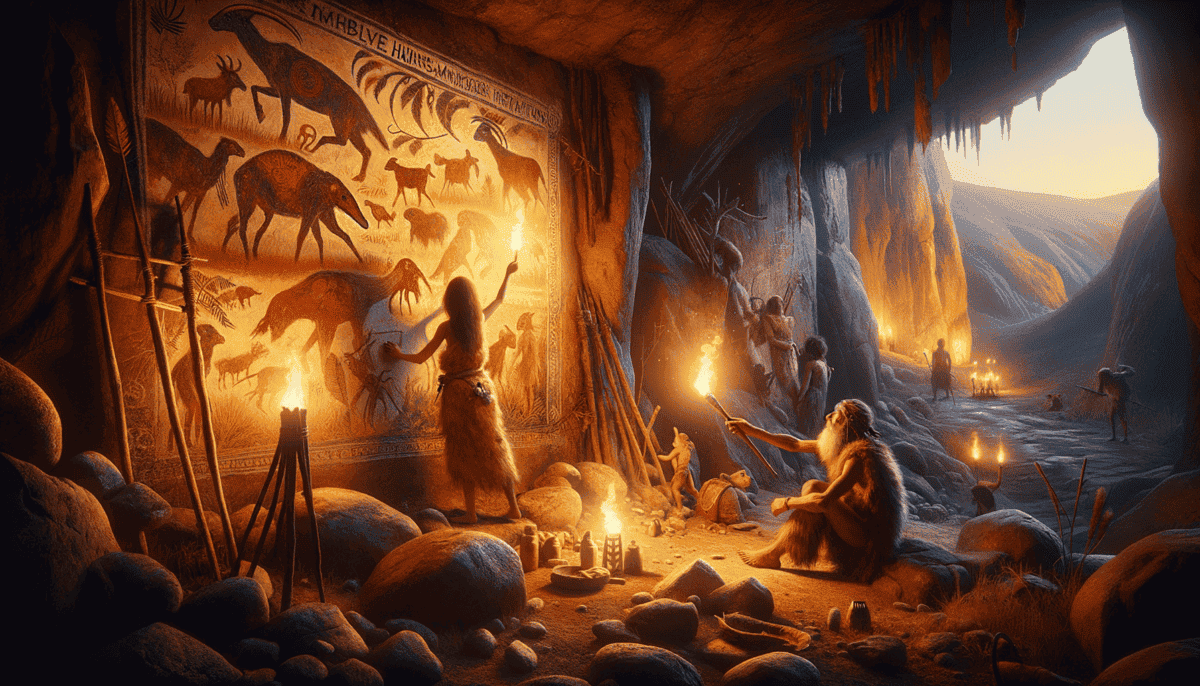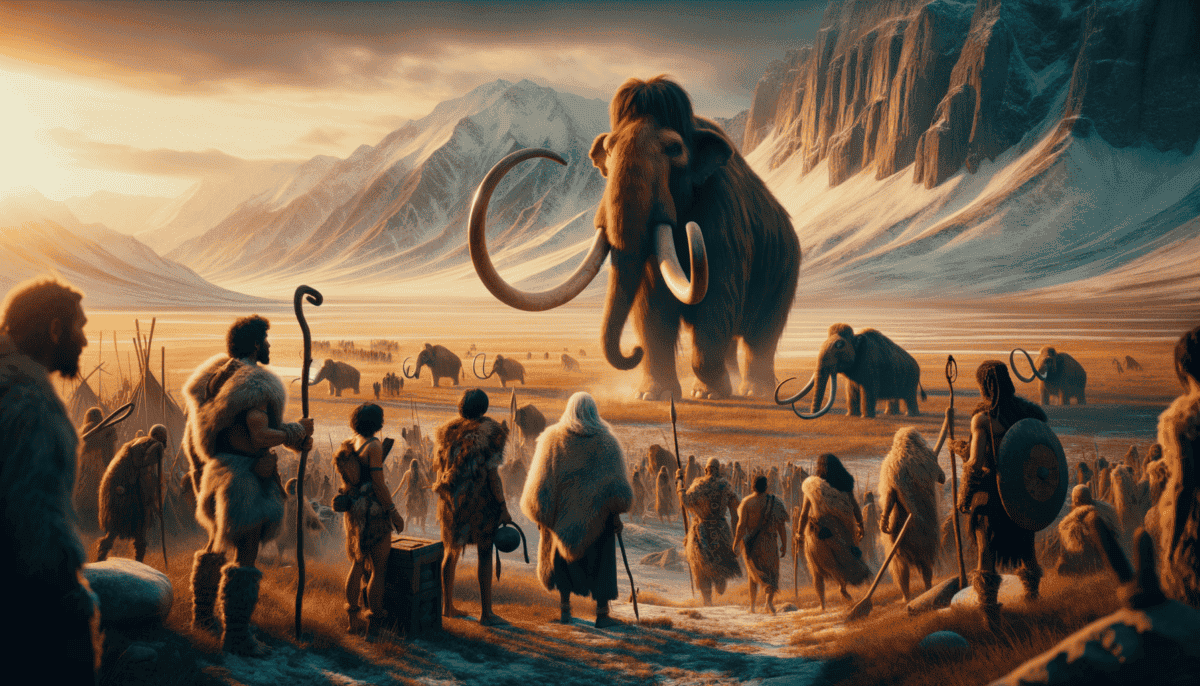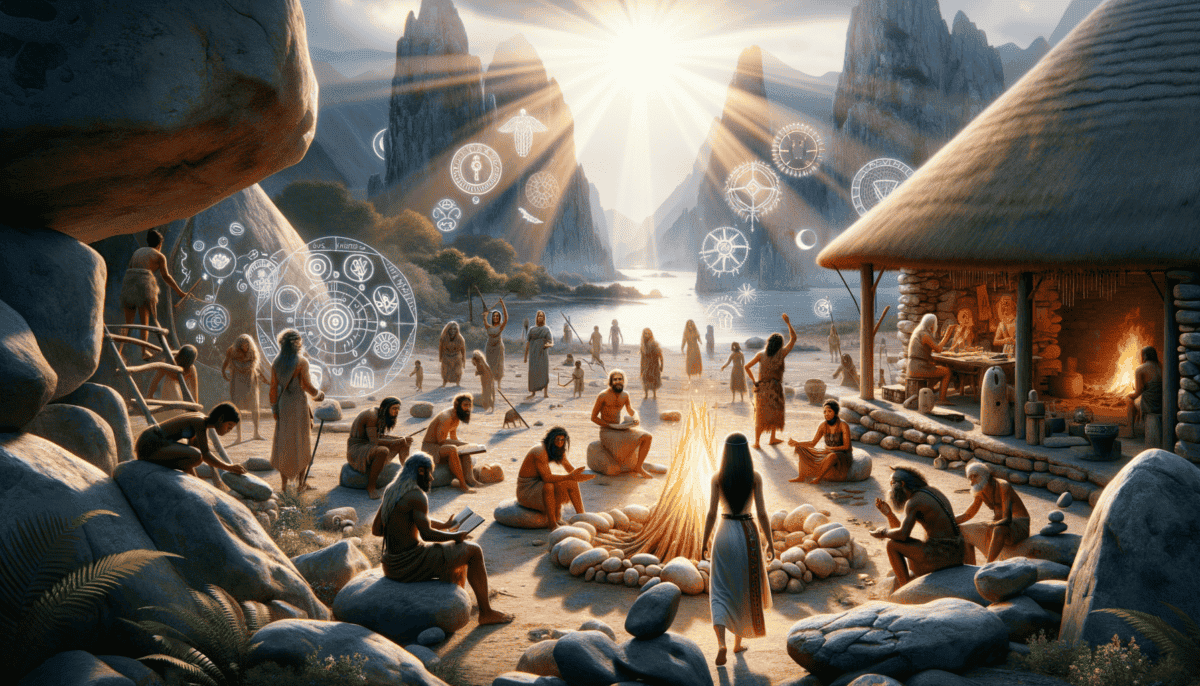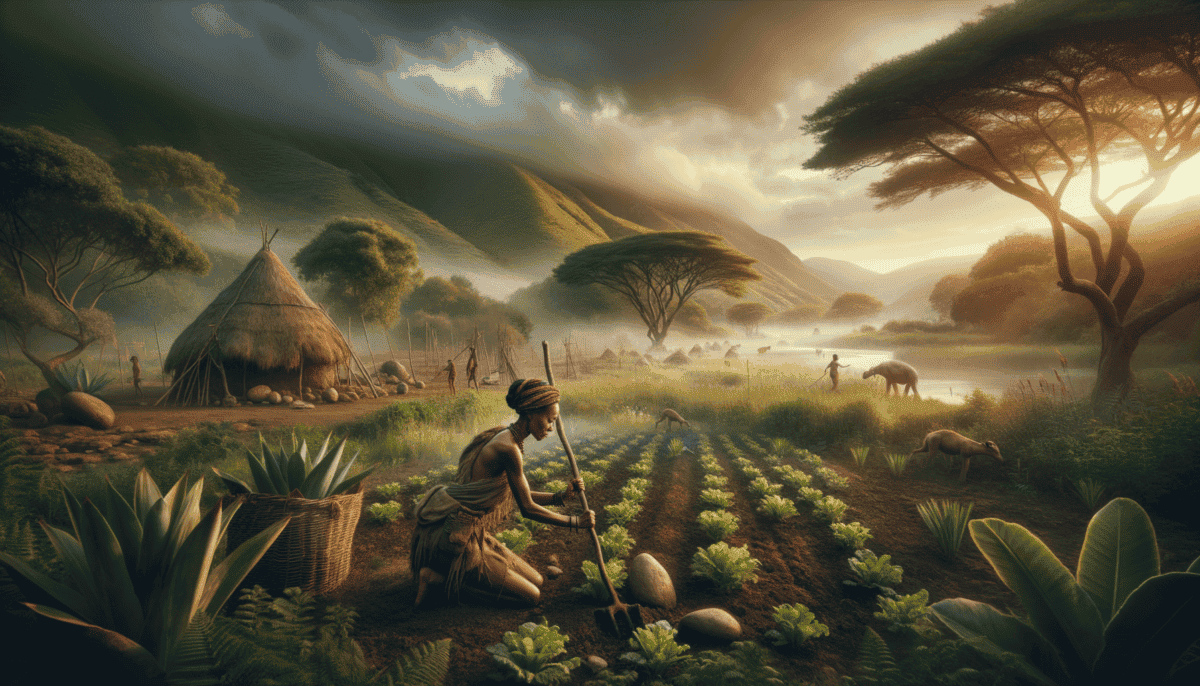First Tools, First Dreams
The morning sun peeked over the hills as Asha stepped out of her family’s shelter. She was ten summers old, with bright eyes that sparkled like the morning dew. Her long dark hair was tied back with strips of leather, perfect for the exciting day ahead.
Today was special. Grandmother Luna would teach her how to make stone tools, just like the grown-ups used for hunting and preparing food.
Asha watched as her grandmother demonstrated how to strike two stones together. Crack! The sound echoed through the valley. Small pieces of stone fell away, leaving sharp edges behind.
“But why do we need tools, Grandmother?” Asha asked, picking up a small stone of her own.
“Ah, my curious child,” Luna smiled, her eyes crinkling at the corners. “Our hands are clever, but tools make us stronger. See?” She held up a sharp stone edge. “This can cut meat, scrape animal skins, and help us survive.”
• Sharp stone edges for cutting
• Hammerstones for breaking nuts
• Bone needles for sewing clothes
• Spears for hunting
Asha tried striking her stones together. At first, nothing happened. She tried again and again. Her hands grew tired, but she didn’t give up. Finally, with one perfect strike, a piece broke off, leaving a sharp edge!
“I did it!” Asha jumped up and down, holding her very first tool.
Grandmother Luna beamed with pride. “Now you understand why we call these our ‘thinking stones.’ They show how clever we humans are.”
That night, as the tribe gathered around the fire, Asha showed everyone her new tool. The elders nodded in approval, and the other children looked at her with wide eyes.
As Asha lay down to sleep that night, she clutched her stone tool close. Through the opening of their shelter, she could see the stars twinkling above. She wondered what other amazing things she would learn to make.
Dreams filled her head: dreams of hunting with spears she would shape herself, of making warm clothes with bone needles, of building better shelters for her tribe. Tomorrow would bring new lessons, new challenges, and new chances to prove herself.
The cool night wind whispered through the trees, carrying the promise of adventures to come. Asha smiled in her sleep, knowing she had taken her first step toward becoming a true toolmaker of her tribe.
Fire and Survival
Dark clouds rolled across the sky as Asha huddled closer to her family. The wind howled through their camp, bringing with it the first icy flakes of winter. ❄️
Elder Koda, the tribe’s fire keeper, gathered everyone around. His eyes gleamed with wisdom as he held up two special sticks.
“Watch carefully, young ones,” he said, placing one flat piece of wood on the ground. “Fire is like a wild animal – powerful but teachable.”
Asha leaned forward, fascinated, as Elder Koda demonstrated. He placed a straight stick against the flat wood and began spinning it quickly between his palms.
• Find dry wood and leaves
• Make a small nest of dry grass
• Spin stick fast between hands
• Blow gently on sparks
“Look!” shouted Little Bear, pointing at the tiny wisp of smoke rising from where the sticks met. Elder Koda carefully added dry grass, then leaves. With gentle breaths, the smoke grew until suddenly – flames!
A cheer went up from the tribe. But their celebration was cut short by a long, low howl in the distance.
“Wolves,” Mother said, pulling Asha closer. “They hunt in the cold too.”
That night, the tribe worked together to keep the fires burning bright. Some gathered wood, while others tended the flames. Asha learned how the fire kept them safe from the wolves and other night hunters.
As the night grew colder, the tribe huddled closer to their fires. They shared stories and roasted meat, their faces glowing in the firelight. Asha practiced making fire with her own set of sticks until her hands were tired.
“You’re learning fast,” Father praised, showing her how to protect the flames from the wind. “Soon you’ll be teaching others.”
When morning came, the ground was white with snow. But Asha wasn’t afraid anymore. She knew that with fire, her tribe could survive anything. Together, they would keep each other warm and safe through the long winter ahead.
That night, as the wolves howled in the distance, Asha felt strong and brave. The fire she helped tend cast warm light across the sleeping faces of her tribe. She was no longer just a tool maker – now she was a keeper of fire too.
Cave Art – Telling Stories Without Words
Asha’s fingers trembled with excitement as she crushed the red berries between her palms. Grandmother Luna watched with a gentle smile, showing her how to mix the juice with soft clay.
The cave was huge and dark, but their fire cast dancing shadows on the smooth stone walls. Asha gazed up in wonder at the paintings that covered the surface – mighty mammoths, swift deer, and brave hunters frozen in time.
“Each mark tells a tale,” Elder Koda explained, pointing to a series of handprints. “These are the hands of our great-great-grandparents, reaching out to us through time.”
• Red from crushed berries
• Black from burnt wood
• Yellow from special clay
• White from ground shells
Asha dipped her hand in the red paint mixture and pressed it carefully against the wall. Her heart beat faster as she lifted her palm away, leaving a perfect print next to those of her ancestors.
“Now,” Mother said, “show us the story of your first fire-making day.”
With trembling fingers, Asha began to draw. She made stick figures gathered around a flame, while dark shapes lurked in the background. Little Bear watched in amazement as the scene came to life.
As the day went on, more tribe members added their stories to the wall. Father painted a successful hunt, while Mother drew patterns that showed where to find sweet berries when the warm season returned.
“Look here,” Grandmother Luna pointed to an old painting high up on the wall. “This tells of the Great Journey, when our people first came to these lands.”
Asha studied the ancient marks with wide eyes. She could see people walking, following animal herds across vast plains. The pictures seemed to move in the flickering firelight.
“Tomorrow we will hunt the big deer,” Father announced, drawing a map on the wall. “These marks will guide us to their grazing grounds.”
That night, as the tribe slept, Asha stayed awake a little longer. She watched the firelight play across their painted stories, making them dance and come alive. She wasn’t just a keeper of fire now – she was also a keeper of stories.
Under the gentle glow of the flames, Asha added one last thing to her painting – a small figure holding up a torch, brave and strong against the darkness. It was her way of saying, “I was here, and this is my story.” ⭐
The Great Mammoth Hunt
Dawn painted the sky pink as Asha crouched behind a snow-covered boulder. Her heart thumped like a drum in her chest. Today was special – she would join her first mammoth hunt!
Little Bear squeezed her hand. They had practiced for many moons for this day. The whole tribe was spread out across the valley, hidden and waiting. Elder Koda had taught them everything about tracking these giant beasts.
“Look!” Mother pointed silently. Through the morning mist, huge shapes moved slowly. The ground trembled with each heavy step. A family of mammoths was coming their way!
• Some hunters make noise to guide the mammoths
• Others wait with spears by the cliff edge
• The youngest hunters carry torches to light the way
• Everyone must stay very quiet until the signal
Asha gripped her torch tightly. Her job was important – she would help guide the mammoth family toward the trap they had prepared. The snow crunched softly under her feet as she got ready.
The largest mammoth lifted its trunk, testing the air. Its tusks gleamed like moonlight on snow. The baby mammoth stayed close to its mother, trumpeting softly.
“Now!” Father’s signal cut through the silence. Asha jumped up with her torch, joining the line of hunters. They waved their flames and shouted, creating a wall of fire and noise.
The mammoths trumpeted in surprise, turning away from the flames. Just as planned, they moved toward where the other hunters waited. The ground shook as the great beasts ran.
“Keep the line steady!” Elder Koda called. The hunters moved as one, just like in their practice drills. The mammoths followed the path they created, exactly where they wanted them to go.
Suddenly, the baby mammoth stumbled! It cried out, and the mother turned back. This wasn’t part of the plan! The huge beast charged toward Asha’s group, trunk raised high.
“Quick thinking!” shouted Father. Asha remembered their cave paintings – how the hunters always stayed together. She raised her torch higher and stepped closer to Little Bear, making their fire barrier stronger.
The mother mammoth stopped, confused by the wall of flames. She trumpeted again, then turned to follow her baby, which had gotten back up and rejoined the herd. The hunt was back on track!
Hours later, the tribe celebrated around their fires. The hunt had been successful – they had enough meat to feed everyone for many moons. Nothing would be wasted; they would use the bones for tools, the fur for warm clothes, and the tusks for special ceremonial items.
That night, Asha added new paintings to their cave wall – the story of her first mammoth hunt. She drew herself standing strong with her torch, the mighty mammoths, and all the tribe working together. Above the paintings, she pressed her hand print in red clay – now she was truly a hunter. ⭐
Language Awakens
Asha sat by the fire, watching the shadows dance on the cave wall. The successful mammoth hunt had changed something in her tribe. They needed new ways to share their hunting wisdom. Pointing and grunting wasn’t enough anymore. ️
Asha practiced the new sounds eagerly. It was like magic – making noises that everyone understood! She pointed to her spear and made the new sound they had chosen for it. Little Bear smiled and copied her.
The tribe gathered each evening to learn more sounds. They created special noises for:
• Weather changes
• Different plants they ate
• Danger warnings
• Family members
“Listen carefully,” Grandmother Luna said, touching her throat. “Feel how each sound is different in your mouth. Just like different berries have different tastes, different words have different shapes.”
Asha practiced with her friends, making the new sounds while they worked:
“Food!” Little Bear responded, showing her some gathered nuts.
“Friend!” they both said together, laughing at their success.
One day, while tracking deer, Asha discovered something amazing. She could put sounds together to tell a whole story!
The older hunters were impressed. Father beamed with pride as Asha taught younger children the new way of talking. She showed them how to make different sounds for different times:
“Sun-up” meant morning
“Moon-high” meant night
“Snow-coming” meant winter was near
As the tribe learned more sounds, amazing things happened. They could plan better hunts, share stories about the past, and warn each other about dangers they couldn’t see.
“Remember when we could only point and make faces?” Little Bear laughed one day. Asha smiled – it seemed so long ago now.
The cave paintings took on new meaning too. Now they could tell the stories behind each picture using their special sounds. Elder Koda taught them to make different sounds for things that happened in the past or things they wanted to do in the future.
“Yesterday we hunted,” meant it already happened.
“Tomorrow we will hunt,” meant it was going to happen.
Some sounds became more important than others. The sound for “danger” could save lives. The sound for “love” made people feel warm inside. The sound for “together” reminded everyone they were part of something bigger. ❤️
One evening, as stars filled the sky, Grandmother Luna gathered everyone around the fire. She made a new kind of sound – a song! It told the story of their tribe, their hunts, and their dreams. Everyone joined in, adding their own sounds to the melody.
Asha realized that with these new sounds, they could share not just what they saw, but what they felt and thought too. She could tell Mother she was scared before a hunt, or tell Father how proud she was after catching her first fish.
That night, Asha lay awake, listening to the night sounds – owl calls, rustling leaves, and the soft breathing of her sleeping family. She thought about how each sound had meaning, just like their new words. The world was full of messages, if you knew how to listen.
Seeds of Civilization
The warm spring sun peeked over the horizon as Asha noticed something strange near their cave. Tiny green shoots were poking through the earth where they had dropped seeds from last season’s berries.
Grandmother Luna hobbled over, her eyes twinkling with wisdom. “The Earth Mother gives us a gift,” she said softly. “When we drop seeds, new plants grow.”
This discovery sparked an idea in Asha’s mind. Instead of always searching for food, what if they could make it grow near their cave? She gathered her tribe to share her exciting thought.
“If we put seeds in the ground on purpose,” she explained, “we could have food growing right here!”
Elder Koda nodded thoughtfully. “Like the berry bushes that grow where birds drop seeds. We could do the same!”
The tribe began their first garden, carefully placing seeds in the soft earth:
• Grain seeds they usually gathered
• Root plants they discovered were good to eat
• Herbs that helped heal wounds
• Seeds from sweet fruits they found
Every day, Asha and the children tended their growing plants. They pulled weeds, brought water from the stream, and watched in amazement as tiny sprouts reached toward the sky.
As their garden grew, the tribe realized they needed to stay in one place longer. They built stronger shelters using wood and mud, creating their first real homes.
The tribe still hunted and gathered, but having their garden meant they didn’t need to move as often. This gave them time to make other discoveries. They learned to:
Make better tools for digging and planting
Build fences to keep animals away from their crops
Store seeds for the next growing season
Create special containers for water
One morning, Asha noticed something amazing. A wild goat had wandered near their camp with its baby. Instead of hunting it, Little Bear had an idea.
The tribe carefully approached the goat, offering it food. Over time, more animals began staying near their settlement. They learned to care for these animals, just like their plants.
Life was changing in wonderful ways. Their new words helped them share knowledge about growing food and caring for animals. They created special sounds for:
Weather patterns
Animal care
Growing seasons
Harvest celebrations
As seasons passed, other tribes visited to trade and learn. Some brought new seeds and animals. Others shared different ways of building homes and making tools.
One evening, as the tribe gathered around their fire, Grandmother Luna spoke of changes she had seen in her long life. From wandering hunters to settlers with gardens and animals, their people had grown in amazing ways.
Asha looked around at their thriving settlement – the gardens full of food, the animals grazing peacefully, the sturdy homes, and most importantly, her tribe working together. She understood now that each discovery led to new ones, like seeds sprouting into plants that made more seeds.
That night, as stars twinkled overhead, Asha added to the cave paintings. She drew pictures of their gardens, their homes, and their animals. Next to them, she painted new symbols for their new words. Future generations would know their story – how their people learned to not just survive, but to create and grow.
Under a full moon, the tribe celebrated with song and dance, sharing food from their gardens and milk from their goats. Their world had grown bigger and richer than they ever imagined. And still, Asha knew, there were more discoveries waiting to be made.


